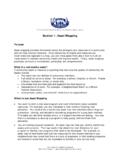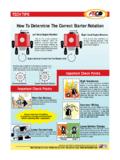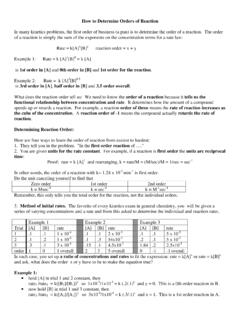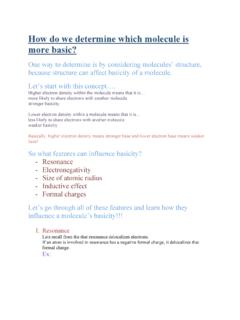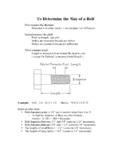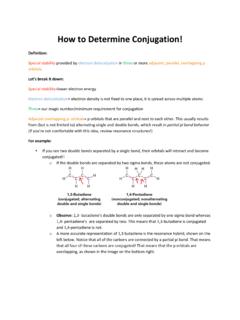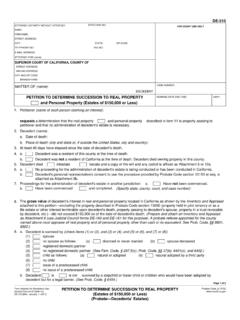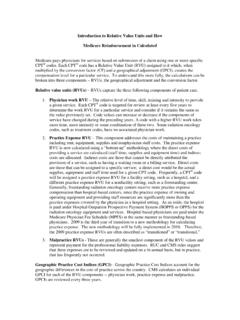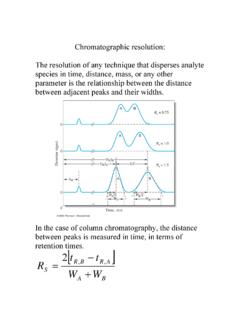Transcription of STEP 4: DETERMINE HOW TO GET THE INFORMATION …
1 Performing a Community Assessment 29. STEP 4: DETERMINE HOW TO GET THE INFORMATION ( collect data ). Now that you have identified what data is needed to answer your questions and have identified potential secondary data sources, it is time to DETERMINE what data , if any, you need to collect from scratch. This is called primary data . Step 4 has three activities, which are reflected in the Step 4 Planning Worksheet: data Collection Plan (following page 5-35): Identify What New data Needs to be Collected Select the Appropriate data Collection Method(s). Revisit Steps 1-3 to Ensure You're on Track Identify What New data Needs to be Collected Once you have filled out the Step 3 Worksheet data , it will become clear what data you can access, and what data you cannot. Now is the time to decide what data you need to collect in order to answer your primary assessment questions.
2 First circle each of the data sources listed in the third column in the Step 3 worksheet that your community partnership does not think can be accessed through any identified secondary data sources. If there are many sources of data , then you need to facilitate another consensus-building process with your partnership to prioritize which data is the most important to answer your stated questions. Here are some helpful hints to consider when determining which data to collect : Be flexible you may need to refine or modify your data decisions after deciding which methods are most feasible and appropriate for your community partnership to conduct. Go back and forth between activities and , as they will ensure you make sound decisions everyone in the partnership feels are achievable. Don't reinvent the wheel borrow data or data collection processes from local sources, similar community assessment efforts, or anything you can find on the Internet.
3 The less you need to create from scratch, the more time and effort you can spend on other parts of the process. Don't bite off more than you can chew collect less data well, rather than collecting lots of data poorly that won't end up being useful. It's more important to answer one assessment question well, than only answering parts of many assessment questions. Your results from answering the first question may help you find the funding, staff skills and data collection processes you need to answer another question later. UCLA Center for Health Policy Research Health data Program data , Advocacy and Technical Assistance 30 Performing a Community Assessment Be humble constantly ask for input and help from community partners and other community stakeholders about data collection. The more others are engaged, the easier it will be accomplish what you have set out to do.
4 Select the Appropriate data Collection Method(s). (Given Time, Staffing, Resources and Skills). The most difficult part about selecting the most appropriate data collection method is making sure that your partnership has the resources to perform that particular methodology. In Appendix A: Methods (page 5-1), you will find detailed descriptions and instructions on how to perform each of the following data collection methods: 1. Asset Mapping 2. Focus Groups 3. Key Informant Interviews 4. Surveys 5. Community Forums 6. Rapid Appraisal Techniques Using the Step 4 Planning Worksheet, brainstorm with your partnership to develop your data collection plan. Here are some helpful questions for your partners to consider: Which of these methods has anyone used before? What were those data collection experiences like?
5 What was challenging and what was successful about using these methods in the past? Which data collection methods were more successful than others? What are some difficulties you encountered when using these methods? Which method or methods do you think would best collect the types of data you have prioritized? Which method or methods do you think would best answer the assessment questions you have prioritized? What would be the potential benefits of using this particular method(s) for the assessment? What challenges do you imagine the partnership might face if you used this particular method(s) for the assessment? Do you think this partnership can collect data through this method(s), given the available staffing, skills, and funding? If not, what might be a better method to use? UCLA Center for Health Policy Research Health data Program data , Advocacy and Technical Assistance Performing a Community Assessment 31.
6 What community members would be the best to target with this method? Which of your prioritized types of data from Step 3 will each method specifically collect ? Which of your primary assessment questions from Step 2 will this method specifically answer? What activities need to take place in order to perform this data collection method(s)? (see the Methods Appendices for details on conducting data collection methods). Which community partner or members will be responsible for carrying out each activity? What is the timeline or due date for each specified data collection activity? Keep in mind that there are two different kinds of data you can collect , quantitative and qualitative. Depending on your partnership's level of data collection expertise, time frame, and level of funding or other resources, you may want to collect just quantitative data , just qualitative data , or a combination of both, in order to answer your assessment questions.
7 Quantitative data are usually measured and expressed in the form of numbers or percentages. This data can answer the who, what, when and where questions of an assessment. Qualitative data is usually measured and expressed in the form of words, concepts, themes, or categories rather than numbers. Qualitative data is often used to gain a more in-depth understanding of a particular incident or phenomenon they answer how or why something is occurring. UCLA Center for Health Policy Research Health data Program data , Advocacy and Technical Assistance 32 Performing a Community Assessment Here are some important distinctions between quantitative and qualitative data that may help you in your decision-making: Quantitative Qualitative Description Measured and expressed in Measured and expressed in the the form of numbers or form of words, stories or statistics themes Also called numeric data Also called anecdotal data Can answer the who, what, Can answer the how or why when and where of an issue Used to gain a more in-depth understanding of an issue data Collection Secondary data Observations Methods Surveys Focus group Interviews Surveys Interviews Benefits Can demonstrate cause and Richer.
8 More in-depth effect INFORMATION about the topic Can represent a being studied community by capturing the Can provide data from perspectives of many respondents in their own words respondents Can collect new data and new Usually easier to interpret ideas from respondents in a dynamic and unstructured way Drawbacks Unable to provide rich, in- Cannot demonstrate cause and depth data effect Cannot collect new ideas or Usually not able to represent . responses only those a community thought of previously Can be difficult to interpret Note that surveys and interviews can collect quantitative or qualitative data , depending on whether the question is asked in a closed- or open-ended format. An example of a closed-ended question may be: How many times have you seen a doctor during the past six months? Answer choices: 0, 1-2, 3-4, 5 or more.
9 An example of an open-ended question may be: What challenges, if any, have you faced when trying to see a doctor in the past six months? In addition, multiple methods can be combined to collect both quantitative and qualitative data at one time. For example, focus group participants can be given a brief quantitative survey before or after the focus group, in addition to the qualitative discussion that would occur during the focus group. UCLA Center for Health Policy Research Health data Program data , Advocacy and Technical Assistance Performing a Community Assessment 33. We recommend that both kinds of data be collected, if possible, because they serve two very different and necessary functions when attempting to paint a complete picture of your community's health experience. Quantitative data can describe the size of a health problem and DETERMINE its associations with other issues, such as demographic factors or insurance coverage.
10 Qualitative data helps give meaning and appropriate interpretation of the quantitative data , as well as answering why and how . The data Collection Methods chart below outlines the methods discussed at length in Appendix A: data Collection Methods, and provides some useful comparisons of advantages and disadvantages. Once you have selected the appropriate data collection method or methods, you will want to complete the data collection plan included as the Step 4 Planning Worksheet. Some important issues you will want to consider for this data collection plan include: 1. What types of data (identified in step 3) will be collected with each data collection method? 2. How would you define the source of data for each data collection method more specifically? In other words, define your target respondents.
